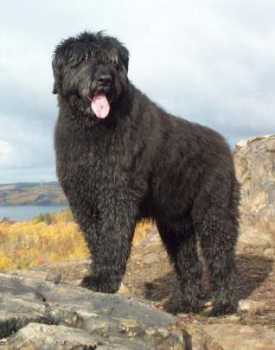When the Normans from France (Gaul) conquered England in 1066 AD, they undoubtedly introduced many of their dogs. The St. Hubert Hound was one of those brought to England, and figured in the formation of the Foxhound. But the original specimen refined with Talbot or Southern Hound and called Bloodhound in English also found favor in the British Isles and America.
His ability to discern a cold trail and persistently follow it for many hours gave rise to another profession. Law enforcement officials soon put him to work finding lost persons or trailing criminals. A documented story of a Kentucky Bloodhound named "Nick Carter" tells of the dog following a trail 104 hours old, leading to the discovery and arrest of a fugitive. This same dog's skill resulted in the capture and conviction of more than 600 criminals! Many other records
of equally amazing feats are recounted among Bloodhound owners. Trails ranged from a short ten feet to 138 miles; one dog caught 23 escaped convicts in only a day-and-a-half of work.
This reputation as a tracker, especially of fugitives, is the one most people have in mind when they think of the Bloodhound. Movies and fictional stories encouraged the image of a fearsome, baying hound with fangs bared, pursuing escapees through the swamps.
Actually, the Bloodhound is a silent trailer, not announcing his presence. Although he certainly could track down a runaway, he might be more likely to greet the pursued with a licking tongue when he reaches his goal. The track is the only thing in his mind; he is not a pugnacious dog at all! In fact, the Bloodhound is much more frequently put to the trail of lost children or strayed hikers.
The modern Bloodhound is familiar around the world. Although not the identical dog of the monastery, he is officially named the Chien de St. Hubert in Belgium, after his ancient, extinct ancestors. This breed still may be referred to by this title in non-English-speaking countries. But whether Bloodhound or St. Hubert Hound, it is the same large, stolid dog with the long scrolled ears, sad countenance, facial wrinkles and hanging flews and dewlap.
Since he was bred to do his own thing rather than slavishly follow his master's every command, he may seem to be slow on the uptake. Training takes patience, and the instinct to track demands an enclosed yard. His single-mindedness means that, for his own safety, the "sniffer'' should not be allowed off leash. Obedience is not his forte, but if you lay a track, you will be able to stand back in admiration. His sense of smell is so much more acute than a human's, it is difficult to fathom; it has been said to be two million times greater. Just think what a garbage can—or a frightened, sweating human—smells like to this breed—a veritable potpourri of scents!
Roger Caras, well-known animal lover and author of A Celebration of Dogs, considers "Yankee," the Bloodhound who shared his home, "vain, even arrogant . . . splendid, magnanimous, noble . . . superb ... a blessing and a miracle."

